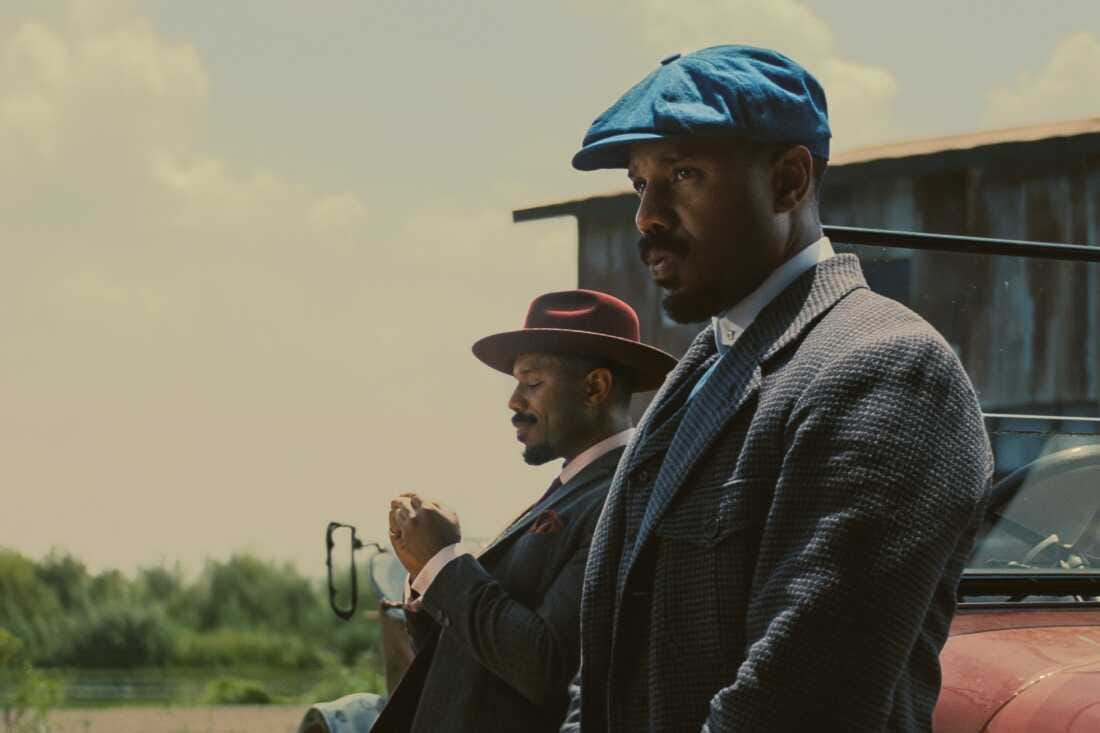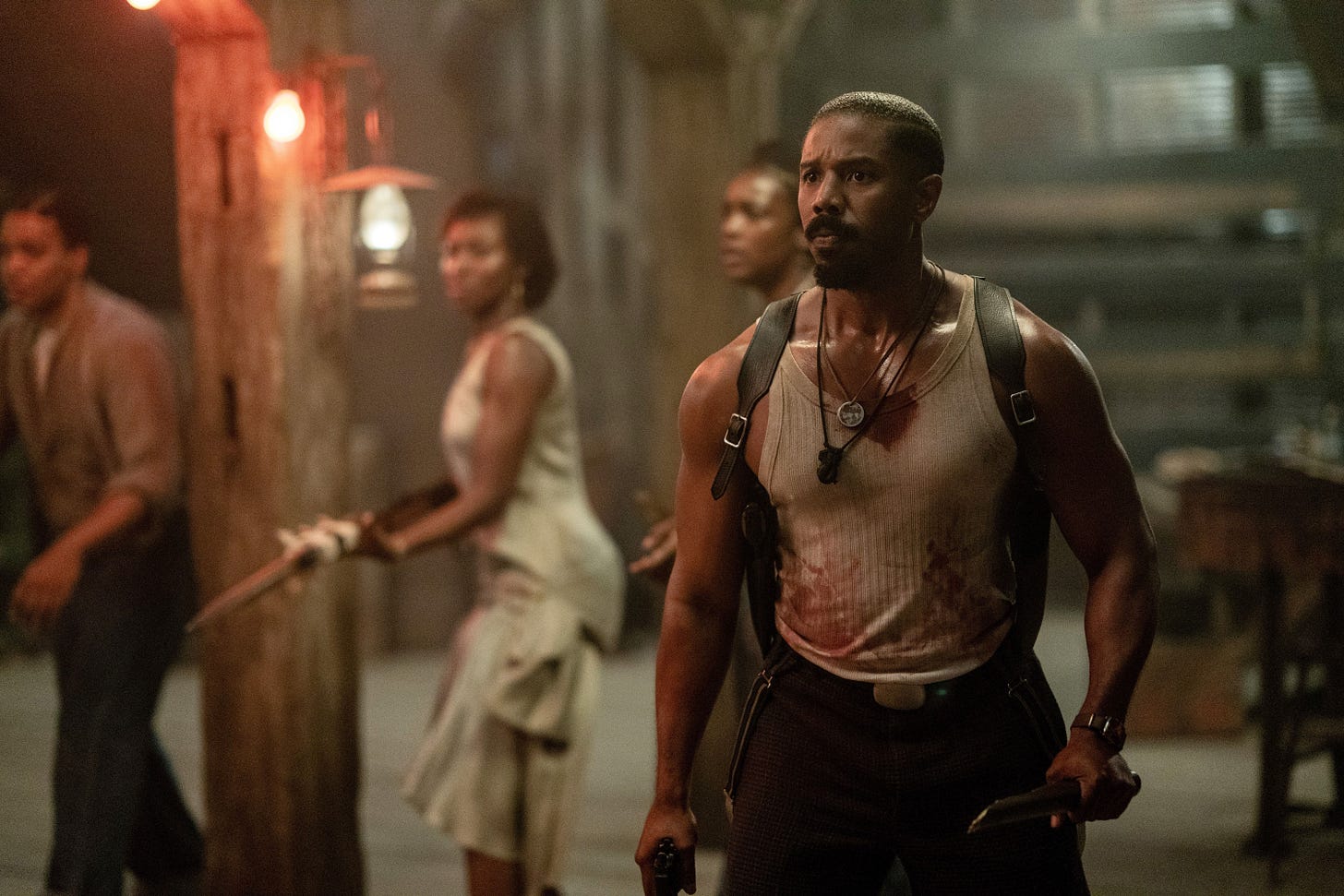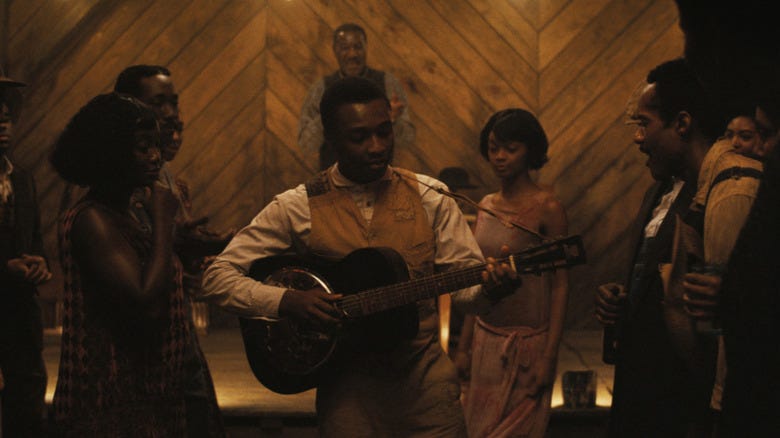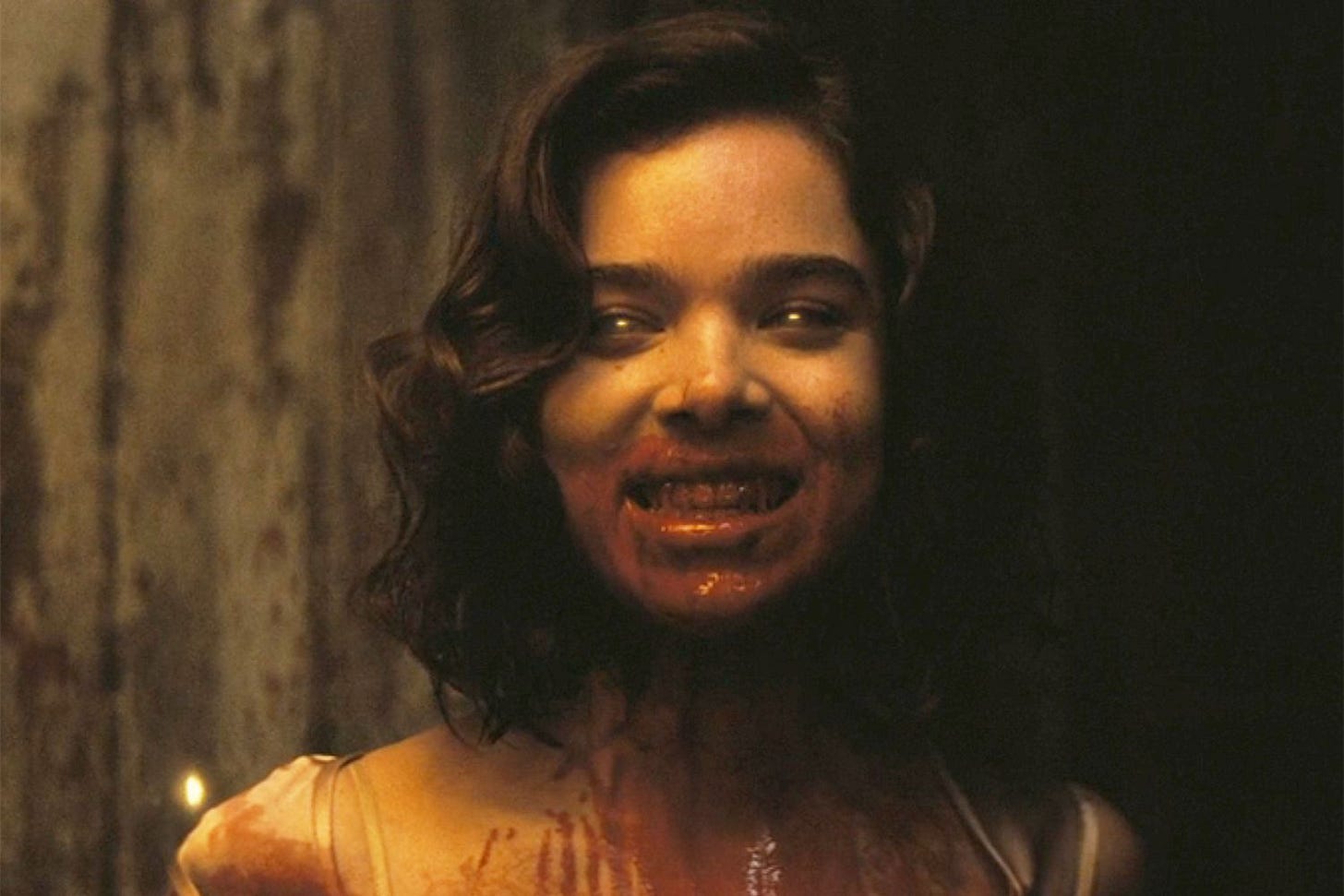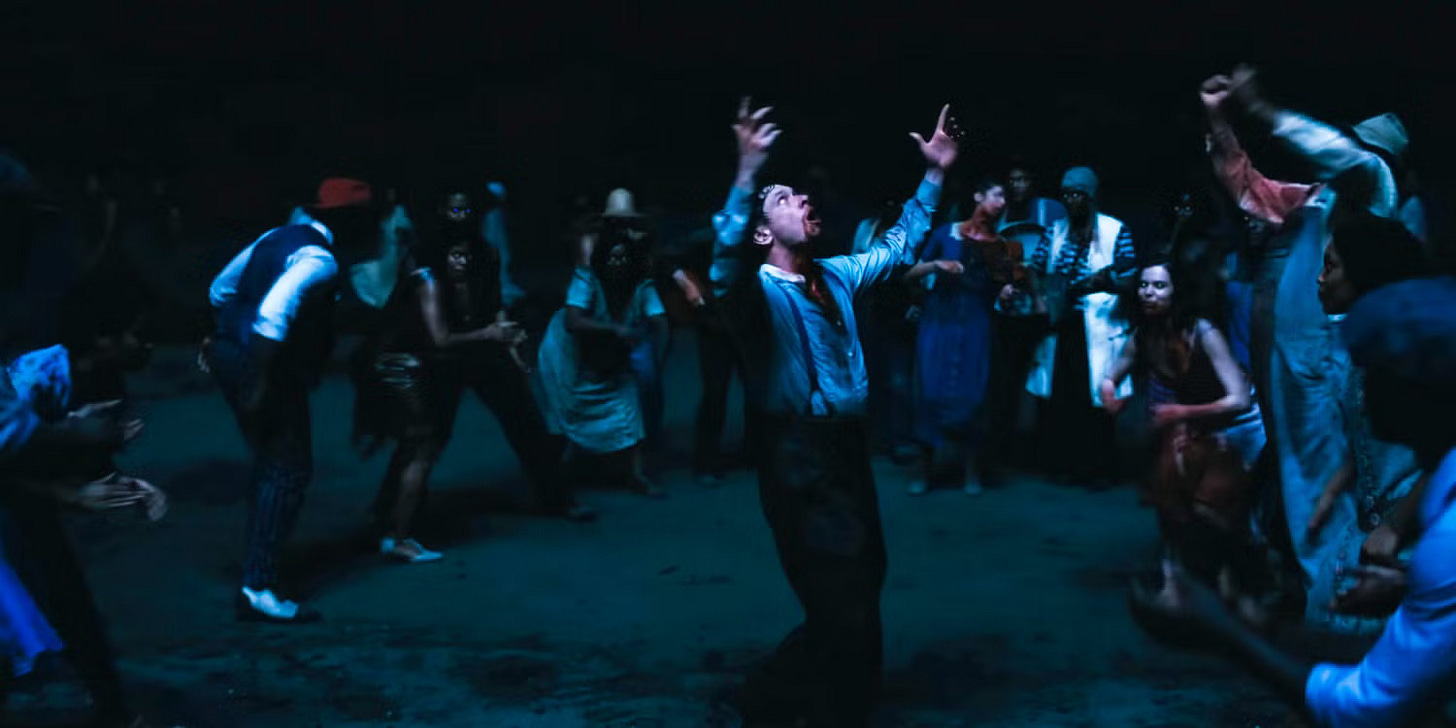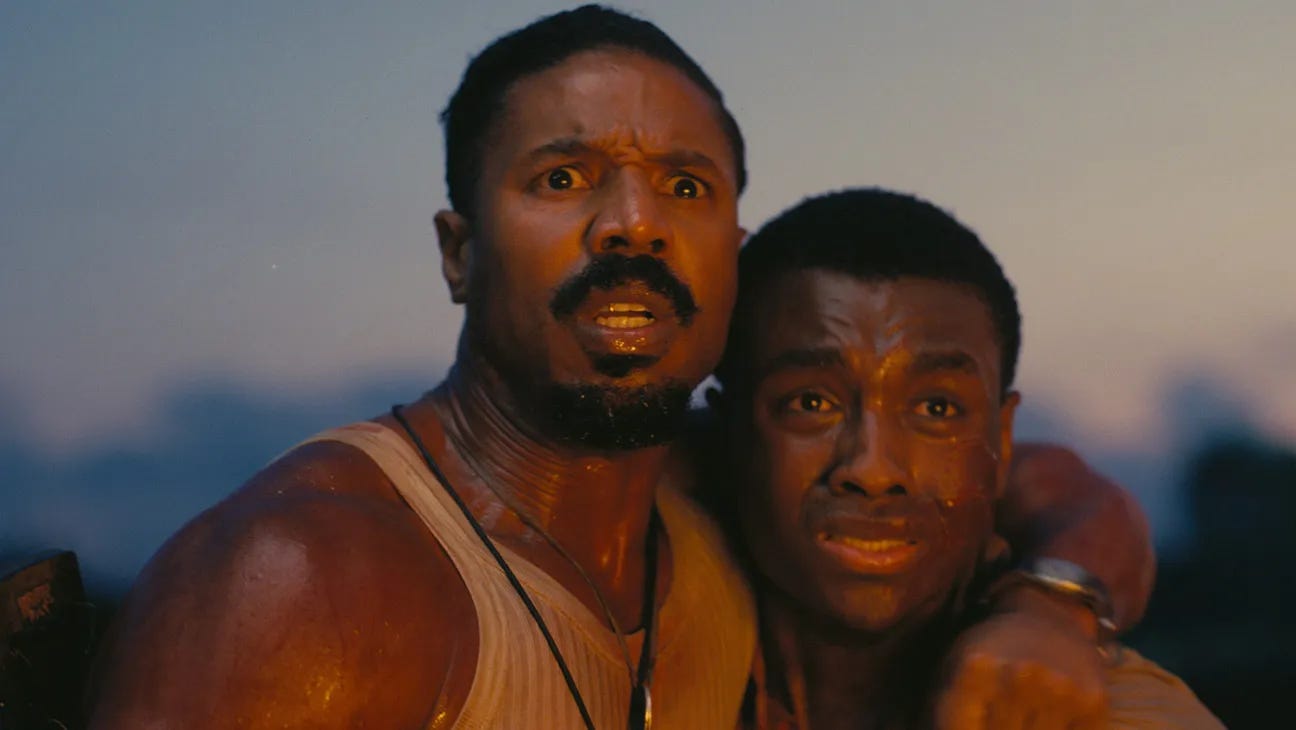The theatrical release of Sinners came about a month and a half too late. Ideally it would have hit theatres in late February or early March, to better coincide with the consonant material in my American Weird class, the material I just spent four posts excavating. See, if it had come out then I totally would have organized a class excursion to see it together and made it an impromptu addition to the course.
Instead, a different serendipity: literally an hour or so after posting my fourth instalment on the Relative Weird in which I discuss Lovecraft Country, my wife and I drove to the local mall to see Sinners. I hadn’t planned on posting anything about it … but then I saw it and have since then been furiously jotting down my thoughts. And, frankly, it resonates a little too perfectly with everything I’ve been writing here lately not to talk about it.
But before I start …
I’ll be talking in some detail about the film; I really cannot emphasize enough how much your viewing experience will benefit from knowing as little as possible going in.
So, final warning. Spoilers ahead.
Call this vampire movie From Dawn Till Dawn, as it unfolds (mostly) within that twenty-four-hour period. This is one of those rare films that at once exhibits an admirable economy of storytelling while simultaneously doing so damn much. There is a LOT going on in this two hours and seventeen minutes; it is a testament to Ryan Coogler’s consummate talents that it never feels overstuffed.
The story is quite simple, actually: twin brothers Elijah and Elias, who go respectively by Smoke and Stack (both played seamlessly by Michael B. Jordan), come back to Clarksdale, Mississippi in 1932 after a longish spell away in Chicago. Their time in Chicago, we gather, was not entirely licit, but hugely profitable: they return to their hometown with sacks of cash, a truck full of booze, and a determination to open the best damn juke joint in the South. In this endeavour, they enlist as their musical act Sammy Moore (Miles Caton), a young but preternaturally talented bluesman, and Delta Slim (Delroy Lindo), a bluesman of much longer tenure; they purchase an old disused sawmill from a local racist (and probable Klansman) named Hogwood (David Maldonado); and they press their many old acquaintances and friends into helping out. Though time is short—they want to have their big opening night that very evening—they pull off something magical, with Sammy and Delta Slim lighting the place on fire (metaphorically).
All is going well until a trio of White musicians appear, asking to enter so they may enjoy the music and play along. Their leader is an Irishman named Remmick (Jack O’Connell); the three play for Smoke and Stack and a handful of others, but despite their obvious talent, something feels off about them. They are not invited inside.
Which is a good thing, as they are vampires! Which we know because we just saw Remmick, fleeing a band of Indigenous vampire hunters, take refuge in the shack of a young married couple … who have a set of KKK robes laid out on their couch in plain view. But Remmick cares nothing for that, and in exchange for their hospitality turns them both to undead ghouls.
From this moment the film turns into a siege narrative, as the vampires pick off incautious partygoers venturing outside. One of the victims is Mary (Hailee Steinfeld), the white-passing former lover of Stack, who re-enters the juke, invited back in by the oblivious bouncer Cornbread (Omar Miller)—because of course, why wouldn’t he?—and she seduces Stack and promptly turns him.
Stack’s apparent death and resurrection in demonic form is the turning point. Most of the partygoers have been shooed off, and they come to comprise the undead army outside, while the handful of survivors realize they must resist their entreaties to be let inside (a more difficult task than it may seem at first, as I get into below), and make it until dawn.
Again: a pretty straightforward story. What you don’t get from that synopsis however is the density of Coogler’s storytelling, the richness of the layered themes and symbolism, and its historical texture. This last element is crucial … the reviews of the film have been nothing short of rapturous on this point, celebrating Coogler’s accomplishment in rendering prewar, Jim Crow Mississippi in such granular detail and capturing the realities of the sharecropping lives lived by the balance of rural Blacks in the South. The fact that Sinners is, ultimately, a vampire movie has raised a few hackles, though not in any pointed or loud manner. One does sense however the sentiment that it seems a waste to spend this sort of historical authenticity in a genre offering.
Possibly it goes without saying that I don’t agree—that I don’t see there’s a distinction to be made here. The supernatural element Coogler introduces is entirely consonant with the film’s framing conceit of music as transcendent. The film begins with a brief history of musicians with supernatural talent—“griots” in West African folklore, as well as such figures in Irish (filidh, or Fire Keepers) and Indigenous cultures—whose art is a double-edged sword that can be healing but also attract evil. At its heart, Sinners is a film about music and the way music walks the line between corporeal, bodily pleasures, and spiritual nourishment; it is about the innately cultural qualities of music and how it articulates collective grief and joy; it is also about how music can be an object of desire in itself, something to be appropriated by others. Coogler’s minutely observed historical ethnography is grafted onto such mythologizing: Clarksdale is a real, historical place as well as the mythical birthplace of the blues, where pioneering bluesmen like Robert Johnson were said to have sold their souls to the Devil. Sammy is himself caught between his own passion for music and his preacher father’s disapproval. Dally too often with the Devil, the pastor warns his son, and eventually the Devil follows you home.
The Devil is not so easy to discern in Jim Crow Mississippi, however.
I regret that I was not able to watch Sinners without knowing anything about it. The first half of the film gives little hint of the supernatural threat to come, but that doesn’t mean it is without tension. Smoke and Stack have made their fortune in Chicago, but don’t have much good to say about it. In response to Sammy’s wide-eyed questions about what life is like outside of Jim Crow, the twins dismissively characterize Chicago as Mississippi but with tall buildings. Little difference, in other words, alluding to the fact that the North was never as welcoming to Black folk as was often imagined.
Historically, however, that wasn’t entirely true. When I try to imagine what it would have been like to watch Sinners without foreknowledge of the vampires, I’m quite certain I would assume that what loomed was a confrontation with Hogwood and the Klan. The only thing that felt off to me about the historical details was the idea that someone like Hogwood would suffer Smoke and Stack to (a) purchase White-owned property, (b) threaten to kill any White person stepping foot on said property, and (c) generally be prosperous-looking, well-dressed Black men who show no deference to the White person before them. Such behaviour would not be tolerated in the Jim Crow South, especially in Mississippi, where the mildest of racial transgressions invited lynching.
As it turns out, that confrontation with the Klan was inevitable—it was just pre-empted by the appearance of Remmick and his vampires. And indeed, it is by way of the vampires that we learn of Hogwood’s plan. He would allow Smoke and Stack one night with the juke joint and then descend the next morning with his Klan posse to exact his retribution, reclaim his property, and keep the money they’d paid him. We learn of this treachery in what is, outside of a pair of brilliant musical sequences, my favourite part of the film … and the part of the film where the vampires more than justify their presence narratively, thematically, and otherwise.
When the survivors inside the juke and the vampires without have reached their standoff—with the latter unable to touch the live humans absent an invitation—the vampires resort to persuasion. Join us, they say. We will grant you immortality and take away the pain of life. The vampires comprise a true collective, as they can share thoughts: Stack tells Smoke about Hogwood’s plan, which he knows because the first people Remmick turned were the young married couple, the husband of the pair being one of Hogwood’s Klansmen whose hood and robes we saw laid out. It’s true, the erstwhile Klansman admits. But he and his wife both profess now to have transcended the hate that animated their mortal lives. They, along with the others, promise community and love.
It is a tempting offer, more than it would be in other tellings: they were never going to let us have this, Stack tells his twin—this was rigged from the start. It is in this moment that Sinners articulates the sensibility I just spent four posts describing, in which recent Black-authored and -focused horror complicates the distinction between safe and complacent reality on one hand, and supernatural horror on the other. The reality these characters inhabit is terrifying enough, with monsters like Hogwood making demons and devils superfluous. Indeed, one wonders if perhaps the legend of blues musicians selling their souls for musical virtuosity isn’t an allegory of the origin of the blues itself, a genre that emerges from the collective trauma of being Black in America. This reading suggests itself in a story Delta Slim tells earlier in the film, of a time he and a fellow musician played for a party of wealthy White people. They liked our music, he tells Sammy and Smoke, but they didn’t like us much. Still, they were well paid—and where Slim drank away the largesse, his friend was shanghaied by the Klan who, finding his wad of cash, lynched him for an invented offense. Slim concludes his story with a bitter laugh and starts drumming on the car dashboard, humming a blues tune and inviting Sammy to sing along. That’s the blues, this moment says—no infernal Devil needed, mortal White people will suffice.




